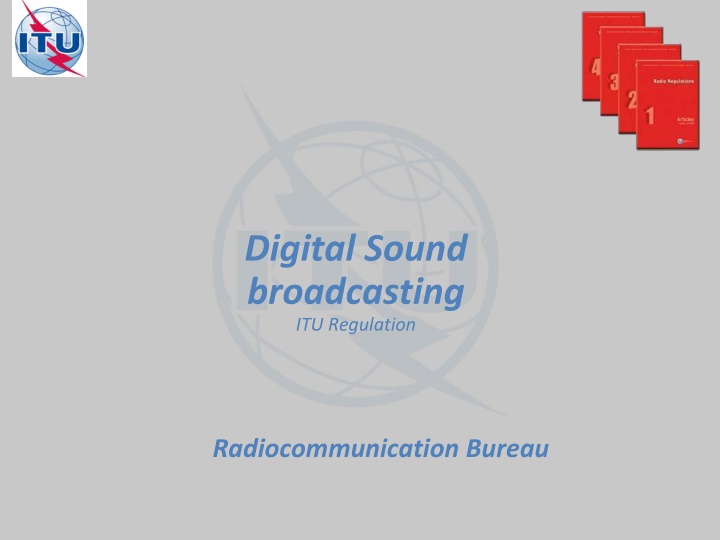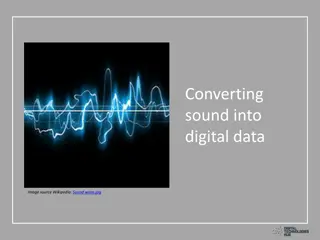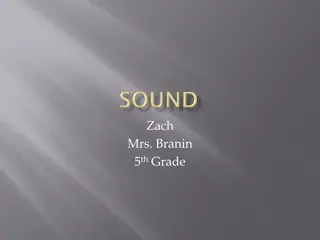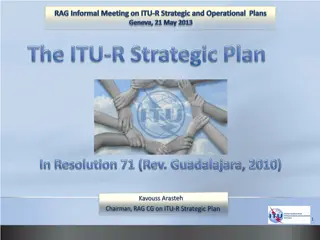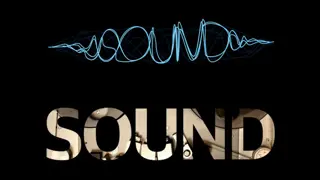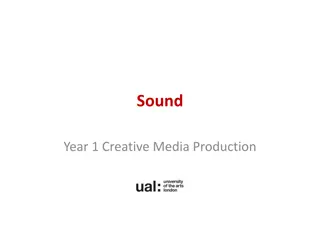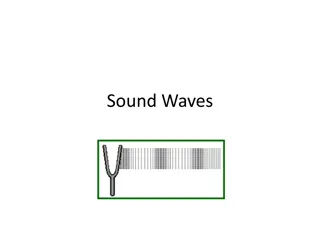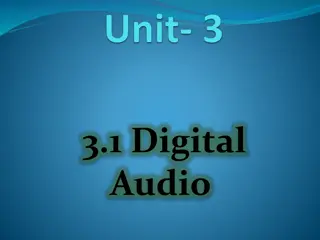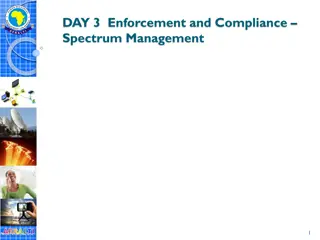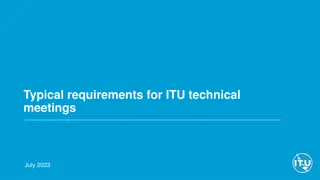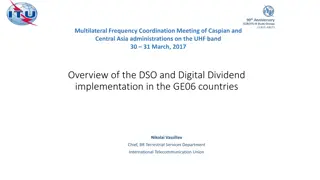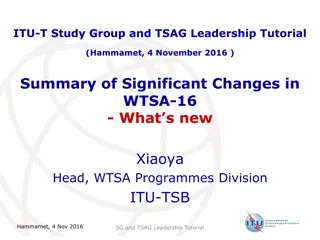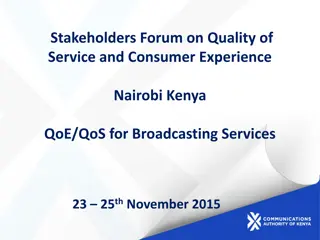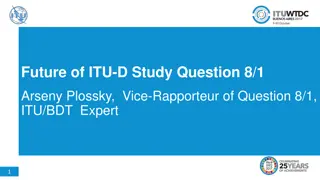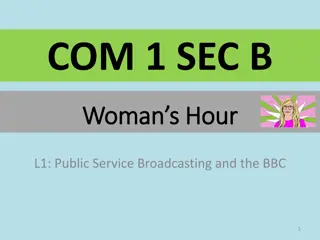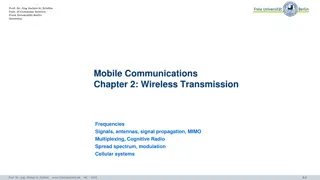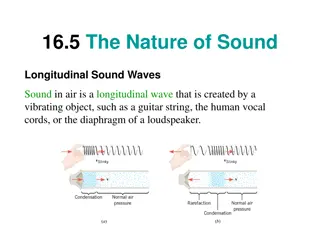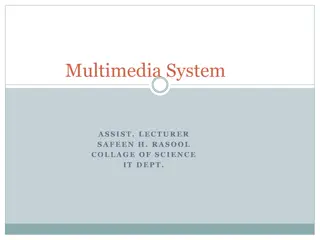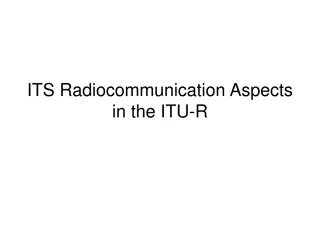ITU Regulations and Frequency Coordination for Digital Sound Broadcasting
The International Telecommunication Union (ITU) plays a crucial role in regulating digital sound broadcasting through its Radio Regulations (RR) and Frequency Coordination processes. The ITU establishes legal frameworks, including the ITU Constitution and Convention, to govern the use of spectrum and orbits internationally. Radio Regulations define frequency allocations and set regulatory procedures for coordination and notification to avoid interference. Effective frequency coordination ensures equitable access and harmonized spectrum usage. The introduction of digital sound broadcasting involves regional agreements and frequency bands for broadcasting, shaping the future of broadcasting technologies.
Download Presentation

Please find below an Image/Link to download the presentation.
The content on the website is provided AS IS for your information and personal use only. It may not be sold, licensed, or shared on other websites without obtaining consent from the author.If you encounter any issues during the download, it is possible that the publisher has removed the file from their server.
You are allowed to download the files provided on this website for personal or commercial use, subject to the condition that they are used lawfully. All files are the property of their respective owners.
The content on the website is provided AS IS for your information and personal use only. It may not be sold, licensed, or shared on other websites without obtaining consent from the author.
E N D
Presentation Transcript
Digital Sound broadcasting ITU Regulation Radiocommunication Bureau
ITU instruments Constitution (CS) and Convention (CV) Establishes the legal basis for the Union Defines: purpo se, structure, rights and obligations of Member States Radio Regulations (RR) and Rules of Procedures (RoP) Binding international treaty that governs the use of the spectrum and the orbits in an international level Administrations adapt their national legislation accordingly Regional Agreements, Special Agreements, ITU-R Recommendations, Reports and Handbooks Complement the basic instruments
Radio Regulations (RR) RR two main concepts: Frequency allocations: Article 5 of the RR contains the Table of Frequency Allocations and Footnotes RR are revised and updated during the World Radiocommunication Conference (WRC) every 3-4 years Next WRC will be in 2019 Regulatory procedures: coordination, notification and recording
Frequency Coordination is Key! To avoid harmful interference Frequency coordination Protection of current and future national plans Equitable access Effective, and harmonized use of the spectrum
Introduction of digital sound broadcasting Regional Broadcasting Agreements And HFBC ..
Frequency bands for Broadcasting Regional Plans ( HF) Frequency Band BC/BT Region Geo. zone Plan (kHz/MHz) LF MF 148.5-283.5 kHz 526.5-1 606.5 kHz 525-1 605 1 605-1 705 BC BC BC BC R1 R1 and R3 R2 R2 GE75 GE75 RJ81 RJ88 VHF /UHF 47-68 MHz 47-68 87.5-100 87.5-108 162-170 MHz (170 MRC)174-230 230-238, 246-254 470-862 BC, BT BT BT BC BT BC , BT BT BT EBA ABA EBA R1* MRC R1-MNG+IRN See RR 5.252 R1-MNG+IRN ST61 GE89 ST61 GE84 ST61 GE06 GE89 GE06 * and part of R3
Introduction of Digital Sound in Regional Agreements (LF/MF) GE75 RJ81 RJ88 LF:150 285 kHz; MF 525 1 605 kHz; MF: 535 - 1605 1 605 1 705 kHz R2 R2 R1 and R3 Rule of Procedure (RRB): Transmission systems DRM A2 and B2. Radiation reduced by at least 7 dB in all directions w.r.t analogue assignment CCRR/20(6 September 2002), the BR concluded that the formulations in the RJ88 Agreement would permit the introduction of digital modulation DRM A3 or B3 and also perhaps that of IBOC DSB Does not provide the possibility of introducing digital modulation in the bands concerned. subject to completion of the studies related to co-channel, first and second adjacent channel protection ratios and subject to further limitations at the band edges in order to be consistent with RR 4.5. Question ITU-R 120/6 (2006) Digital sound broadcasting in Region 2 has been adopted by Study Group 6E. Temporary measure until the decision from a competent conference
Introduction of Digital Sound in Regional Agreements (VHF/UHF) GE06 ST61 GE84 174 230 MHz (Band III) 41-68 MHz 87.5 108 MHz: FM 1.536 kHz T-DAB Regions 1 & 3 Regions 1 & 3 Region 1 &Iran possible under 3.1 of Chapter 3 of Annex 2 to GE84: not cause greater interference, Nor require higher protection under RoP Part A2/ST61 paragraph 5 same coordination distances as analogue systems Adopted T-DAB as planned standard for digital sound broadcasting Implementation of alternative standards under envelope of Plan entries : DVB-T 1 4 T- DAB blocks (Prov. 5.1.2 e + RoP A10) T-DAB Other digital systems (Prov. 5.1.3) Problematic to introduce new digital assignments in congested bands No submission or notification to date
Introduction of digital HFBC 12.7 6 of RR: Other modulation techniques recommended by ITU-R Res. 517 (Rev.WRC-03) Introduction of digital modulation schemes shall be permitted in place of double- sideband or single- sideband emissions, provided that the level of interference caused to existing emissions is not increased. 5 900 26 100 kHz Entry into force July 2003
Digital Broadcasting Not under Regional Agreements Frequency to be in conformity with article 5 of the RR (11.31) System: No specific standard Conditions: for ex.: 5.86 In Region 2, in the band 525-535 kHz the carrier power of broadcasting stations shall not exceed 1 kW during the day and 250 W at night. Notification and recording in the MIFR Article 11 of the RR
ITU-R recommendations Recommendation ITU-R BS.1514-2: System for digital sound broadcasting in the broadcasting bands below 30 MHz. Recommendation ITU-R BS.1114-7: Systems for terrestrial digital sound broadcasting to vehicular, portable and fixed receivers in the frequency range 30-3 000 MHz. Recommendation ITU-R BS.774-3: Service requirements for digital sound broadcasting to vehicular, portable and fixed receivers using terrestrial transmitters in the VHF/UHF bands.
Radio Platform-Chelmsford (England)-1920 Thank you ITU Radiocommunication Bureau Questions/request of assistance: brmail@itu.int
